82d General Hospital Unit History
Introduction & Activation:
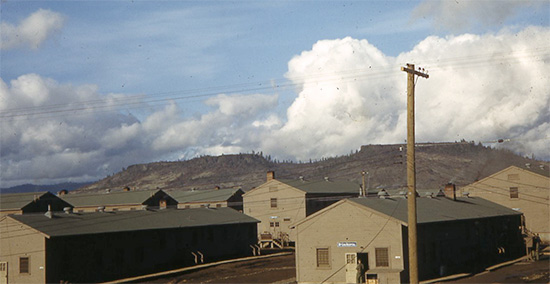
Partial view of Camp White, Medford, Oregon. This is the Post where the 82d General Hospital was activated 20 August 1942.
Headquarters
82d General Hospital
Camp White, Oregon
4 September 1942
General Orders
No. 1
Activation of 82d General Hospital:
In compliance with War Department Letter AG 320.2 (7-14-42) MR-M-GN, dated July 16, 1942, and Section II, General Orders Number 80, Headquarters Ninth Service Command, dated August 15, 1942, the 82d General Hospital is activated.
Opening of Headquarters, 82d General Hospital:
Headquarters, 82d General Hospital is opened at Camp White, Medford, Oregon (Division Camp, total acreage 49,638; troop capacity 1,884 Officers and 35,557 Enlisted Men –ed), at 0001, PWT, as of August 20, 1942.
Assumption of Command:
Under the Provisions of Paragraph 4, AR 600-20, the undersigned hereby assumes command of the 82d General Hospital.
Norman MICHELL,
1st Lieutenant, M.C.,
Commanding

Colonel John W. Rich, MC, O-16973, Commanding Officer, 82d General Hospital next to the organization’s special insignia and motto.
Change of Command:
Headquarters
82d General Hospital
Camp White, Oregon
30 October 1942.
General Orders
No. 2
1. Assumption of Command: Under the provisions of Paragraph 4, AR 600-20, the undersigned hereby assumes command of the 82d General Hospital, vice 1st Lieutenant Norman Mitchell.
John W. RICH,
Lt. Colonel, M.C.,
Commanding
Training:
The unit was to follow the Mobilization Training Program 8-101 in order to be prepared to receive further training in the Technical – Tactical – and Logistical functions of the unit and the duties of personnel assigned to the unit.
The program was based upon a 48-hour training week (consisting of 6 training days of 8 hours each) for a period of 16 weeks. More time per day could be utilized when desirable, in connection with marches, hikes, field exercises, etc. Open time was not to be considered as free time but could be used to compensate for interruptions, to bring individuals or units up to standard, to provide refresher training, or for purposes of mass athletics, competitive games, and morale building in general.
The MTP 8-101 could be modified if necessary in order to adapt it to training of the type of medical unit in which the personnel were being trained, to shorten or lengthen the time of training in order to conform to the time available, to make the best use of existing facilities and of training expedients, and to conform to climate, terrain, or other conditions affecting the training situation.
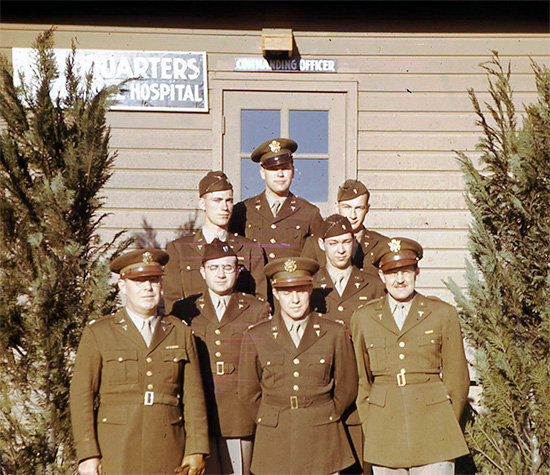
82d General Hospital: Commanding Officer (L) Colonel John W. Rich, MC, O-16973, with General Administrative Staff members, and Executive Officer Major Quintus Nicola, MC, O-338283 (R). Picture taken at Camp White, Medford, Oregon.
The scope of the instruction was as follows:
- First or Basic Period > 1st to 6th week inclusive. During this period the preliminary training of the individual Enlisted Man was stressed. At the end of this period every man was to be able to properly display, and care for his uniform and equipment; understand and practice correctly indoor and outdoor military courtesy; and know the fundamentals of first aid and sanitation; and have an applicatory knowledge of individual defense measures and the essentials of all basic subjects prescribed in the Program.
- Second or Technical Period > 7th to 14th week inclusive. While Basic Training of the individual EM continued, emphasis was now placed upon technical subjects to render him fit for further training in a Medical Department Technical or Administrative specialty, or further training in the operation and functions of the medical unit or installation. In addition to Basic and Technical subjects, Specialist Training was begun as well as Tactical and Logistical Training. Generally, personnel trained in Technical Specialties were able to qualify as unrated Technicians, and possess sufficient technical knowledge to act as Basic Technicians in these medical specialties. Individuals qualified to receive further training in a Medical Department specialty, such as Dental – Laboratory – Pharmacy –Veterinary – X-Ray – Medical and Surgical Technicians, could be selected during subject training period for attendance at a Medical Department Enlisted Technicians School.
- Third or Field Training Period > 15th to 16th week inclusive. Basic and Technical Training were still in progress, but instruction in this period was largely devoted to applicatory exercises in which the soldier applied his knowledge under field and simulated war conditions. Where practicable the EM were moved into the field to live under field conditions during subject period. At the end of the period, personnel were supposed to be able to collect and treat casualties in the field, establish and operate Aid Stations during day and night, and set up the unit installation for operation in conjunction with the associated arms and services.
Note: Prior to any field exercises, all trainees were given a one hour classroom lecture relating to the “Operation and Functions of Fixed Hospitals”. The time dedicated discussed the functional organization, a hasty sketch of equipment and the scope of treatment in a General Hospital, the sources of casualties coming to a General Hospital, the means of transportation in arriving at a General Hospital, and the treatment and disposition of casualties (a Field Exercise usually covered a period of forty hours –ed).
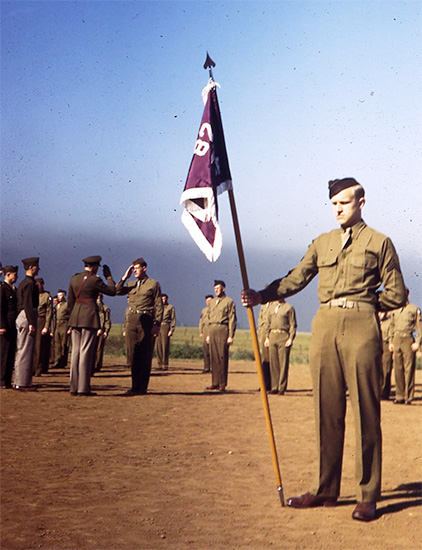
Formation, Camp White, Medford, Oregon. A Corporal holds the unit’s Guidon, while the Officer saluting in the the background (left) is Major Q. Nicola, MC, O-338283, the organization’s Executive Officer.
Preparation for Overseas Movement:
Processing of the Hospital unit was to be used for issuing equipment, physical examinations, immunizations, and the completion of papers, forms, and records required prior to any movement overseas (POM –ed). This program was allotted 16 hours and was generally to be implemented at the organization’s Staging Area or Port of Embarkation.
Pursuant to Directive, Headquarters Western Base Section, Services of Supply, ETOUSA, A.P.O. # 515, U.S. Army, dated 24 March 1944, Subject: “Organization History, “ the following report is submitted:
The 82d General Hospital, stationed at Baxter General Hospital, Spokane, Washington (designated US Army General Hospital by WD GO # 64, dated 24 November 1942, authorized bed capacity 2000, specialized in general medicine, general & orthopedic surgery, and thoracic surgery –ed) was directed to detach the following Officers and Enlisted Men to Fort Hamilton, New York City, as the Advance Party for Overseas Movement, per Authority Movement Order No. 1, Baxter General Hospital, Spokane, Washington, Zone of Interior, dated 5 February 1944:
| Name | Rank | ASN |
| NICOLA, Quintus (NMI) | Major, MC | O-338283 |
| MAYO, Charles H. | 1st Lieutenant, MAC | O-1543762 |
| INGRAM, Jack W. | Staff Sergeant, MD | 38158155 |
| MITCHELL, Frank J. | Sergeant, MD | 32681847 |
| GOFF, Ralph L. | Technician 4th Grade, MD | 39407247 |

Partial view of 82d General Hospital personnel and equipment during general training, while stationed at Camp White, Medford, Oregon.
The Advance Party for the overseas movement of the 82d General Hospital left New York Port of Embarkation on 21 February 1944 as directed by the Commanding General, New York POE, and debarked at Liverpool, England, 1 March 1944, proceeding to Colwyn Bay, Denbighshire, North Wales, where it billeted for about one week, until it moved to Llandudno, Caernarvonshire, North Wales, about 48 hours prior to the arrival of its parent unit.
The remainder of the 82d General Hospital, commanded by Colonel John W. Rich, MC, O-16973, and consisting of 54 Officers, 1 Warrant Officer, 100 Nurses, 3 Hospital Dietitians, 2 Physio-Therapy Aides, 5 American Red Cross Workers, and 502 Enlisted Men, left Baxter General Hospital, Washington, for Boston, Massachusetts, where they boarded USAT “Uruguay” for the Atlantic crossing (also on board were the entire personnel of the 428th Fighter Squadron, on its way to join the Ninth Army Air Force in the United Kingdom –ed). The ship left Boston Port of Embarkation 28 February 1944, arriving at Liverpool, England 10 March. Upon arrival overseas, the personnel safely debarked at Liverpool on 11 and 12 March 1944, and proceeded by train to their overseas staging area at Llandudno.
The unit was met in Llandudno by its Advance Party and promptly taken to various private billeting points. The Mess was shared with other similar units in the area. Within some twenty-four hours after arrival from Liverpool, the 82d General Hospital had already organized its own mess which later also served to accommodate other newly arrived units. The maximum served at any one meal totaled 1000 Enlisted Men and 350 Officers and ARC personnel. Immediately upon detraining at Llandudno, North Wales, each member of the command was given a copy of the overseas edition of the unit’s Special Service Bulletin. Headquarters, 82d General Hospital, received the Army Post Office Number 526.
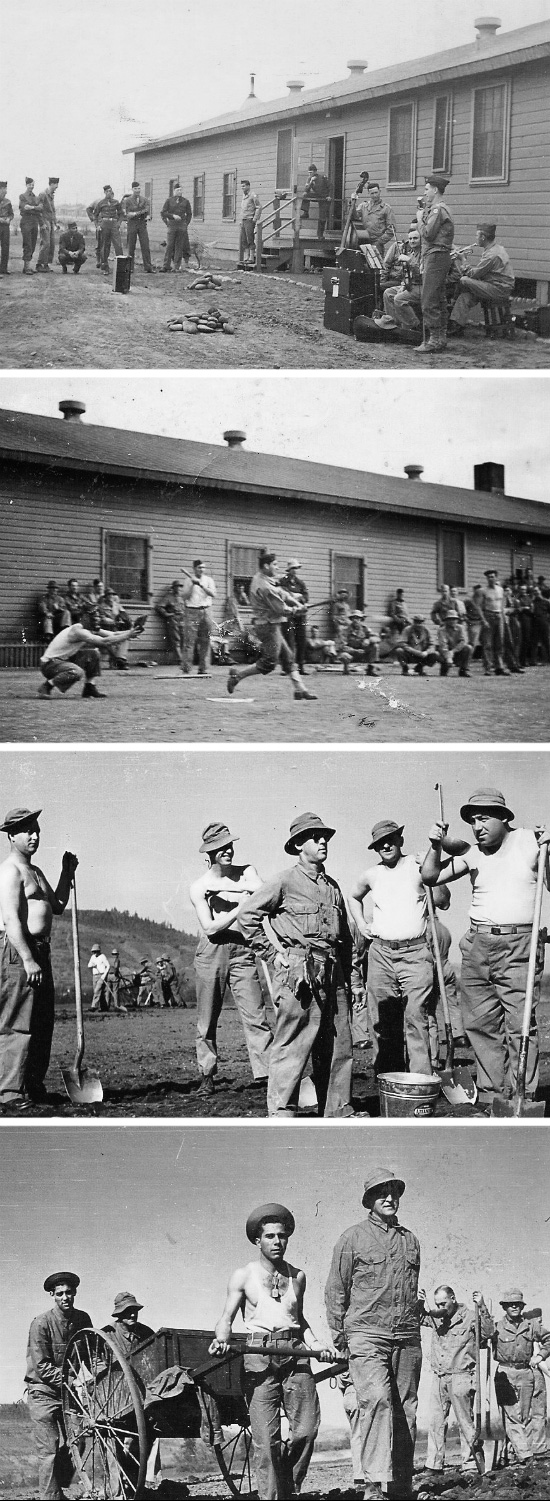
General view of 82d General Hospital personnel in action. There was time for recreation and work details. All illustrations taken while the unit was stationed at Camp White, Medford, Oregon.
The unit’s Bulletin contained a diagrammatic sketch of the city of Llandudno with the locations of the organization’s Headquarters, billeting areas, mess centers, and other significant landmarks. The Bulletin also contained appropriate data relative to the customs, the way of life and the disposition of the local inhabitants. Llandudno was an important Hospital Training Area, hence the large number of U.S. Army Hospitals established in the region.
The preparatory function of the Advance Party was efficiently executed as was evidenced by the smooth operation of the billeting, messing, orientation, and rapid acclimatization of the entire male and female personnel of the 82d General Hospital upon its arrival in unknown and foreign territory.
The unit’s Headquarters was organized and established in the “Claremont Hotel”, Promenade, and the Dispensary was set up at 5 Mostyn Street. Daily sick call was regularly held by the Dispensary Surgeon, Major Ralph (NMI) Rosenberg, MC, O-346475. An Officer (i.e. a Major of the Medical Corps) was in attendance 24 hours daily. Considering the large size of the organization and the new environmental conditions, the sick rate was unusually low for the Officer and EM personnel. For recreation, the basement of the Mostyn Art Gallery building was converted to the “Donut Dugout”.

Aerial view of Jedediah H. Baxter General Hospital, Spokane, Washington, in the 1940s. During their stay, many Officers and Enlisted personnel of the 82d General Hospital were on duty at the different medical facilities to learn and acquire more medical skills.
Training United Kingdom:
A Training Program was carried out for the Enlisted Men, Nurses and Officers under the supervision of Captain Harry F. Hughes, DC, O-366874. This program was preceded by a comprehensive orientation lecture by a visiting Officer from the Western Base Section, ETOUSA, to the entire Commissioned Officer Staff at the Grand Theater Auditorium.
The Training Program for the Enlisted Men included physical exercises, road marches, gas mask drill, interior guard drill, lecture on VD, and professional conferences with the Chiefs of Services.
A special Training Program for the Army Nurse Corps Officers covered such subjects as physical exercise, close-order drill, wearing of the uniform, orientation, military courtesy, conservation of material, and care of records in the European Theater, as well as chemical warfare and general care of equipment.
The Officers’ Training Program included physical exercise, professional group discussions, ETO medical publications, hospital organization and Officers’ conferences.
A Medical Field Training School was established at Shrivenham, Berkshire, England, by the Chief Surgeon, ETOUSA, in 1943. It was particularly designed for General Duty Medical Officers assigned to combat units. Officers of all grades were, however, given the opportunity to attend courses and lectures as circumstances permitted. Instructors were drawn for the most part from the Professional Services Division, Office of The Chief Surgeon, Headquarters, ETOUSA, and each class was instructed in the fundamentals of first aid care of various types of casualties. Lectures were often supplemented by demonstrations and visits to British or American medical installations located in the U.K.

Partial views illustrating the 82d General Hospital’s medical installations at Iscoyd Park, Flintshire.
The American Red Cross personnel, consisting of Miss Helen McKay, Harriet Bontecou, Helen Dike, Edna Hutchinson, and Nancy Booth, were detached at Liverpool to the Headquarters, American Red Cross, London, for personal clearance and special training. They only rejoined the unit 21 March 1944, with the exception of Miss Helen Dike, who recovered from an infection and therefore only rejoined the 82d General Hospital on 30 March 1944, when the unit was set up at Iscoyd Park, Flintshire.
The overall personnel’s conduct and general discipline were a credit to the reputation of the unit. Among several others, Chaplain William J. Harty (Captain), ChC, O-498477, was informed by many civilians of the exemplary behavior shown by the members of the 82d General and commendable impression made by this command upon the City of Llandudno. The civilian Roman Catholic Chaplain was very hospitable and generous in placing all of his facilities at the disposal of the organization. Chaplain Harty further called attention to the large number who attended Mass and received the Sacrament.
No new cases of Venereal Disease developed in the command while stationed in Llandudno, North Wales.
Assignment of a Unit Censor and British-American Liaison Officer were filled by 1st Lieutenant John L. Thomas, MC, O-345888, and Major William O. Van Brunt, DC, O-342949, respectively.
Change of Station United Kingdom:
Pursuant to Movement Order No. 555, Headquarters, Western Base Section, dated 20 March 1944, an Advance Party of 3 Officers and 40 Enlisted Men, under command of Captain Ernest C. Bush, MAC, O-1534227, and 1st Lieutenant John W. Aitken, QMC, O-1579652, were detailed from the 82d General Hospital, to proceed from Llandudno to Iscoyd Park, Flintshire, Wales, 20 March 1944, to prepare the hospital area for occupation by this organization. It should be underlined that at the time Llandudno, in Wales, was considered a Hospital Training Area, where quite a number of medical units were stationed (periods varied), among which the 29th Field – 55th General – 57th Field – 108th General – 112th General – 182d General – 184th General – and the 297th General Hospitals, including the 3d – 15th – 16th – 18th – 20th – 22d – 25th – 26th and the 55th Hospital Trains.
Pursuant to Movement Order No. 616, Headquarters, Western Base Section, dated 26 March 1944, the 82d General Hospital left Llandudno at 1315 hours, 28 March 1944, by train and organic motor transportation, arriving at Whitchurch four hours later, from whence it completed the 3.7 miles to the new hospital area at Iscoyd Park by motor transportation. Headquarters, Dispensary, and a Guard were promptly established by the 82d General Hospital upon its arrival at the proper hospital area.
The Mess was efficiently established by the Advance Party, which had also initiated the organization of the unit’s Headquarters. Billeting quarters were assigned to all personnel. Requisition was made for additional mattresses for the Enlisted Men’s quarters.
Work was begun on the hospital grounds. One telephone with an outside line was made available pending completion and installation of the unit’s telephone switchboard and the securing of the proper civilian personnel. No hospital equipment was received, except for 60% of the motor vehicles. As per T/O & E 8-550 the number of vehicles should have been: 8 ¾-ton ambulances, 2 ¼-ton trucks, 4 ¾-ton carryall trucks, 4 1½-ton cargo 6 trucks, 1 1½-ton dump truck, and 3 2½-ton cargo trucks.
On 31 March 1944, a formal board meeting concerning the hospital area was held, attended by British and American authorities, and at which time the 82d organization assumed control of all Post buildings and installations. The building of the hospital, which was begun over 2 years ago, was adjudged by the building contractors to be almost 90% complete. The remaining construction, as estimated by the contractors, was to be completed in twenty-one days.
While being stationed in Flintshire County, Wales, the 82d Gen Hosp wasn’t the only US Army organization established in the area.
The following miscellaneous units were also operating in Flintshire (period May 1944):
- 1st Medical Concentration Center > Gwernhylod Camp
- 11th Replacement Depot > Bryn-y-Pys
- 12th Hospital Center Convalescent Camp > Gwernhylod Camp
- 30th Medical Hospital Ship Platoon > Overton
- 67th Replacement Battalion > Bryn-y-Pys
- 83d General Hospital Headquarters > Llanerch
- 204th Quartermaster Laundry Platoon > Flint
- 215th Replacement Company > Bryn-y-Pys
- 216th Replacement Company > Bryn-y-Pys
- 350th Replacement Company > Bryn-y-Pys
- 489th Replacement Company > Bryn-y-Pys
- 542d Medical Hospital Ship Platoon > Llanerch
Change in Organization:
With reference to Letter AG 220.33 OpGA (3), issued by Headquarters, United Kingdom Base, Communications Zone, European Theater of Operations, U.S. Army, A.P.O. 871, dated 23 September 1944, and signed by Captain G. R. McLaughlin, AGD, Asst. Adjutant General, all previous Directives issued by Headquarters, Southern Base Section, Communications Zone, and Western Base Section, Communications Zone, attaching or assigning General and Station Hospitals to the 12th – 15th and 6810th Hospital Centers (Provisional) were rescinded. The following organizations were attached for administration as indicated below:
| Organization | Attached to |
| 52d General Hospital | 12th Hospital Center |
| 53d General Hospital | 12th Hospital Center |
| 55th General Hospital | 12th Hospital Center |
| 81st General Hospital | 12th Hospital Center |
| 93d General Hospital | 12th Hospital Center |
| 96th General Hospital | 12th Hospital Center |
| 107th General Hospital | 12th Hospital Center |
| 114th General Hospital | 12th Hospital Center |
| 122d General Hospital | 12th Hospital Center |
| 123d General Hospital | 12th Hospital Center |
| 135th General Hospital | 12th Hospital Center |
| 155th General Hospital | 12th Hospital Center |
| 156th General Hospital | 12th Hospital Center |
| 297th General Hospital | 12th Hospital Center |
| 77th Station Hospital | 12th Hospital Center |
| 123d Station Hospital | 12th Hospital Center |
| 232d Station Hospital | 12th Hospital Center |
| 279th Station Hospital | 12th Hospital Center |
| 307th Station Hospital | 12th Hospital Center |

82d General Hospital. Training at Camp White, Medford, Orgeon and area: hiking and road marches.
| Organization | Attached to |
| 61st General Hospital | 15th Hospital Center |
| 91st General Hospital | 15th Hospital Center |
| 97th General Hospital | 15th Hospital Center |
| 110th General Hospital | 15th Hospital Center |
| 111th General Hospital | 15th Hospital Center |
| 160th General Hospital | 15th Hospital Center |
| 186th General Hospital | 15th Hospital Center |
| 192d General Hospital | 15th Hospital Center |
| 304th Station Hospital | 15th Hospital Center |
| 306th Station Hospital | 15th Hospital Center |
| 317th Station Hospital | 15th Hospital Center |
| 318th Station Hospital | 15th Hospital Center |
| 327th Station Hospital | 15th Hospital Center |

82d General Hospital. Training at Camp White, Medford, Oregon and area: bivouac, tent pitching and relaxation.
| Organization | Attached to |
| 68th General Hospital | 6810th Hospital Center (Prov) |
| 82d General Hospital | 6810th Hospital Center (Prov) |
| 83d General Hospital | 6810th Hospital Center (Prov) |
| 109th General Hospital | 6810th Hospital Center (Prov) |
| 129th General Hospital | 6810th Hospital Center (Prov) |
| 137th General Hospital | 6810th Hospital Center (Prov) |
| 157th General Hospital | 6810th Hospital Center (Prov) |
| 182d General Hospital | 6810th Hospital Center (Prov) |
| 10th Station Hospital | 6810th Hospital Center (Prov) |
| 33d Station Hospital | 6810th Hospital Center (Prov) |
| 36th Station Hospital | 6810th Hospital Center (Prov) |
| 168th Station Hospital | 6810th Hospital Center (Prov) |
| 312th Station Hospital | 6810th Hospital Center (Prov) |
| 316th Station Hospital | 6810th Hospital Center (Prov) |
| 57th Field Hospital | 6810th Hospital Center (Prov) |
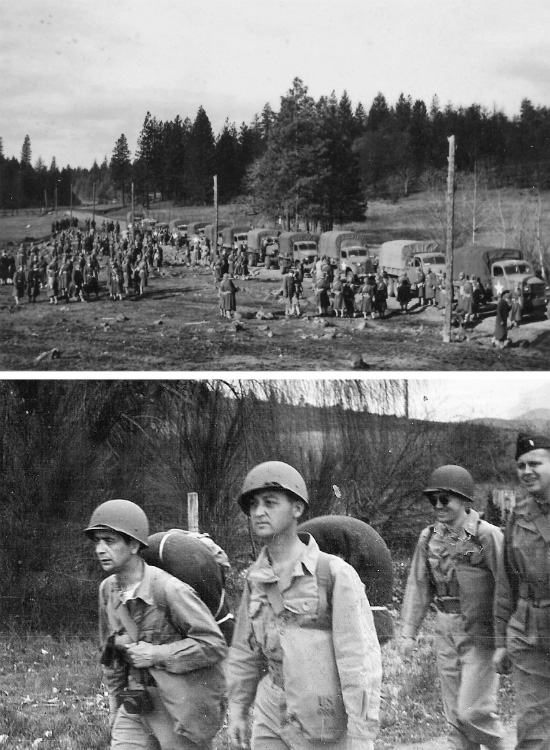
Top: 82d General Hospital. Training at Camp White, Medford, Oregon and area: map reading and compass training.
Bottom: 82d General Hospital. Training at Camp White, Medford, Oregon and area: physical endurance.
Note: Three (3) Hospital Centers were in operation at the time in the United Kingdom. Apart from general medicine, they provided specialized treatment and were therefore foreseen with the necessary equipment and staffed with qualified personnel. These Centers were:
- 12th Hospital Center, Great Malvern, Worcestershire
- 15th Hospital Center, Cirencester, Gloucestershire
- 6810th Hospital Center (Provisional), Whitchurch, Flintshire (later designated the 804th Hospital Center)
In each of the above listed Hospital Centers, there were at least one or more hospitals provided with equipment and personnel for highly specialized treatment of Neuro-Surgery – Thoracic Surgery – Plastic & Maxillo-Facial Surgery – Surgical Treatment of Extensive Burns – and Urological Surgery. The CO of any hospital in the United Kingdom Base lacking facilities and sufficiently qualified personnel for the special treatment of any patient could transfer the patient to the most available Hospital Center or hospital designated for treatment and disposition of such patient.
Operations United Kingdom 1944:
The 82d General Hospital, commanded by Colonel John W. Rich, MC, O-16973, in cooperation with the British civilian contractors, and by means of certain improvisations, completed the physical structures, installations, and grounds of the hospital area at Iscoyd Park, Flintshire, in time for the reception of patients by 25 April 1944, as per VOCO, Chief Surgeon, Western Base Section. The unit was to operate Hospital Plant # 4192.
An official letter from Headquarters, European Theater of Operations, U.S. Army, dated 28 April 1944, File AG 323.4 OpMC, Subject: “Opening of Hospitals”, declared 0001 hours, 29 April 1944 as the official opening date of the 82d General Hospital.
A member of the command, Private Wilbur E. Dixon, 39562240, was the first hospital admission on 27 April 1944.
On the official date of opening, the organization consisted of 58 Officers, 1 Warrant Officer, 100 Nurses, 3 Hospital Dietitians, 2 Physio-Therapy Aides, 5 American Red Cross Workers, and 506 Enlisted Men. There were 18 civilian employees which increased to 28 by 30 September 1944.

Top: 82d General Hospital. Training at Camp White, Medford, Oregon and area: chow line.
Bottom: 82d General Hospital. Training at Camp White, Medford, Oregon and area: medical assistance standby.
On 1 May 1944, 286 patients were transferred at once from the 91st General Hospital to the 82d General. This took place because the 91st Gen Hosp was called upon many times to furnish Officers and Enlisted Men on DS with other medical organizations critically under manpower. On the other hand such movements were part of a training in view of the coming invasion of the Continent, where mass receipt and transfer of patients was expected.
Previous to D-Day, 6 June 1944, several Officers were temporarily reassigned to Dispensary installations serving troop concentrations along the southern coast of England and with invasion units. Two (2) Officers were under considerable fire during the Normandy Invasion: Major Arnold E. Naegli, MC, O-493326, who served on LST # 510, and Major Edward W. Alsberge, MC, O-268030, who served on the British Hospital Carrier No. 49, “Naushion” (converted ex-American ferryboat, which could accommodate between 100 litter and 150 ambulatory patients –ed). 1st Lieutenant Williard E. Hodgkin, MC, O-531417, was more recently assigned to another LST.
Meanwhile in accordance with T/O & E 8-550 C3, War Department, dated 4 March 1944, the ANC personnel in the unit was reduced to 83 Officers by 19 August 1944 (authorized strength was now: 56 Officers, 1 Warrant Officer, 83 Nurses, and 450 Enlisted Men –ed). Other Officer personnel changes included special assignment to the following 82d Gen Hosp Officers:
- Lt. Colonel Cornelius F. Lehmann, MC, O-157864, with duty assignments as Medical Inspector, Chief of Dermatology Service, and Consultant Dermatologist, for the 6810th Hospital Center (Provisional).
- Major Lawrence Goodman, MC, O-315430, with duty assignments as Chief of Surgical Service and Coordinator in General Surgery for the 6810th Hospital Center (Provisional).
- Major Irving Wolin, MC, O-420979, Chief of the Orthopedic Section with assignment as Orthopedic Consultant for the Western District.
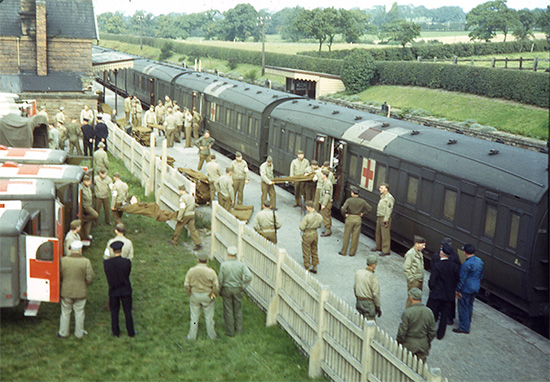
Arrival of German Prisoner of War patients by hospital train at the Malpas railway station. They are bound for the 82d General Hospital, Iscoyd Park, Flintshire. As from 1 October 1944, the organization was tasked with hospitalization and treatment of enemy patients.
Principal Duty Assignments – 82d General Hospital
Commanding Officer – Colonel John W. RICH, MC, O-16973
Executive Officer – Major Quintus NICOLA, MC, O-338283
Adjutant – 1st Lieutenant Lawrence B. EDLIN, MAC, O-1544329
Personnel Officer – 2d Lieutenant John O. TALLMAN, MAC, O-2048795
Principal Chief Nurse – Captain Ruth GREEN, ANC, N-737809
Chief of Medical Service – Lt. Colonel Frederick KELLOGG, MC, O-284789
Chief of Surgical Service – Major Lawrence H. GOODMAN, MC, O-315430
Chief of X-Ray Service – Major Ralph M. BELL, MC, O-402485
Chief of Laboratory Service + Unit Historian – Major Morris F. WIENER, MC, O-264174
Rehabilitation Officer – Major Ralph ROSENBERG, MC, O-346475
Intelligence Officer + Special Service Officer – Captain Earl K. BURNSIDE, MAC, O-1534226
Commanding Officer Medical Detachment + Provost Marshal – Captain William E. KNIGHT, MAC, O-1543614
Commanding Officer Detachment of Patients – Warrant Officer Junior Grade Leonard A. MORLEY, W-2126264
Post Chemical Officer – 1st Lieutenant Benjamin N. HORWITT, SnC, O-522907
Fire Marshall + Motor Transportation Officer – 2d Lieutenant Richard A. NOWACKI, QMC, O-1581303
Post Sanitation Officer – Captain James M. BEEBE, SnC, O-623811
Mess Officer – 2d Lieutenant Edward L. O’TOOLE, MAC, O-1544503
Medical Supply Officer – 1st Lieutenant Charles H. MAYO, MAC, O-1543762
Post Quartermaster – 1st Lieutenant John W. AITKEN, QMC, O-1579652
American Red Cross Assistant Field Director – Miss Helen McKAY, ARC
The 82d General Hospital became part of the 6810th Hospital Center (Provisional) per Authority Letter, File 220.33 OpAG, Headquarters, United Kingdom Base, Communications Zone, European Theater of Operations, U.S. Army, 23 September 1944, Subject: ”Attachments.”
Official inspections of the hospital plant and its facilities, professional work, military conduct, administration, and personnel were frequent and thorough, while stationed in the United Kingdom. Inspectors included Major General Paul R. Hawley (Surgeon General, ETOUSA), Colonel Mark Green (Chief Surgeon, Western Base Section, United Kingdom Base), and Major Charles J. Cataldo (6810th Hospital Center (Prov).
The morale of the command was heightened by the following factors and measures:
- having begun to fulfill the hospital’s mission
- excellent mess facilities
- furloughs and passes made available
- organized sports, athletics, dances, USO (United Service Organizations –ed) shows and CEMA (Council for the Encouragement of Music and the Arts –ed) concepts
- adequately furnished clubs for the NCOs and the lower ranks
- excellent mail service
- adequate Post Exchange
- Red Cross facilities
- adequate religious services
The unit meanwhile received 90% of its organic transportation. Each of the trucks averaged 1000 miles per week. In accordance with T/O & E 8-550 War Department, dated 3 July 1944, the number of authorized vehicles included: 6 ¾-ton ambulances, 6 ¼-ton trucks, 1 ¾-ton weapons carrier, 4 1½-ton cargo trucks, 2 2½-ton cargo trucks, 1 2½-ton dump truck, 4 ¼-ton cargo trailers, 2 1-ton cargo trailer, and 2 1-ton (250-gallon) water trailers.
The question of adequate hospital supplies was quickly dissipated on 10 April 1944 with the arrival of the 41-car loads (goods on railroad wagons) containing the complete assembly, designated “CZ-97325”. The rapid unloading and hauling of these supplies from the railhead was made possible by the willing cooperation of nearby Quartermaster Truck units. Fortunately, the 82d General Hospital was among the first of such units to be supplied with all-American equipment. This was supplemented by British supplies as arranged for by “Program C” and Reciprocal Aid (Reverse Lend-Lease –ed), the latter furnishing bacteriologic media through the “Media Manufacturing Center”, smallpox vaccine through the “Government Lymph Establishment”, and medicinal gases through the “British Oxygen Company.”
The bed capacity of the hospital was expanded to 1516 by the setting up of hospital tents on 23 June 1944.
Total admissions for the period 1 April 1944 up to 30 September 1944 included 3764 white and 288 colored U.S. Army personnel. Additional patients from other branches and organizations were eventually received including, U.S. Army – U.S. Navy – U.S. Merchant Marine – British Armed Forces – Free French Forces – civilians, and from 27 September 1944 on, mainly German Prisoners of War.
Some Statistics (4 May 1944 – 30 September 1944)
| Convoy | Patients | Authority | Arrival Date |
| 1 – train | 273 | SO 124, Hq 5th Gen Hosp, 3 May 44 | 4 May 44 |
| 2 – air | 48 | SO 125, Hq 79th Gen Hosp, 4 May 44 | 5 May 44 |
| 3 – train | 287 | SO 28, Hq 91st Gen Hosp, 7 May 44 | 8 May 44 |
| 4 – air | 25 | SO 136, Hq 79th Gen Hosp, 17 May 44 | 19 May 44 |
| 5 – air | 49 | SO 139, Hq, 79th Gen Hosp, 20 May 44 | 22 May 44 |
| 6 – train | 254 | SO 51, Hq 91st Gen Hosp, 3 Jun 44 | 3 Jun 44 |
| 7 – train | 279 | VOCO, OCS, ETO, 315th Sta Hosp | 18 Jun 44 |
| 8 – train | 289 | VOCO, OCS, ETO, 130th Sta Hosp | 10 Jul 44 |
| 9 – air | 26 | Informal Transfer, HU, 1st ASCZ Evac | 7 Aug 44 |
| 10 – air | 53 | Informal Transfer, 634th Med Clr Co, Evac Cen | 8 Aug 44 |
| 11 – train | 292 | Informal Transfer, 98th Gen Hosp | 9 Aug 44 |
| 12 – train | 290 | Informal Transfer, 98th Gen Hosp | 14 Aug 44 |
| 13 – train | 270 | Informal Transfer, 110th Sta Hosp | 27 Sept 44 |
| 14 – train | 307 | Informal Transfer, 110th Sta Hosp | 28 Sept 44 |
| 15 – train | 292 | Informal Transfer, 228th Sta Hosp | 30 Sept 44 |
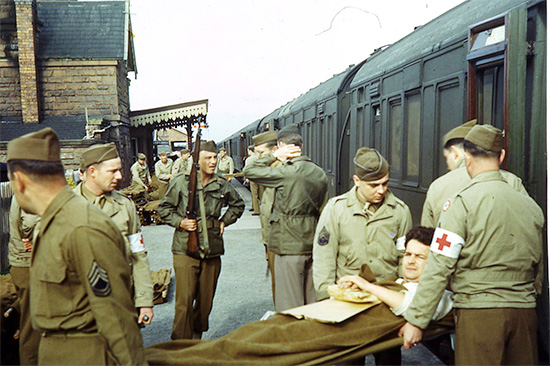
More enemy patients arrive at Malpas station (3.7 miles away from Iscoyd Park on the railway line between Chester and Whitchurch). Following debarkation, the prisoners were to board buses for transportation to the installations of the 82d General Hospital at Iscoyd Park.
The methods used in the above convoy system proved to be efficient. The care and rapidity were a credit to the Medical Detachment personnel and to their good training. In the period from 29 April 1944 to 30 September 1944, the various services accomplished the following:
Surgical: performed 154 major procedures, 1149 minor procedures, applied 918 plaster casts; the Physiotherapy Section treated 1320 patients and gave 27212 treatments
X-Ray: examined 4384 patients requiring 354 fluoroscopies and 10094 film exposures
Dental: examined 1654 patients, and accomplished 1635 restorations and 337 prostheses
Laboratory: performed 38037 tests consisting of chemical, bacteriologic, serologic, hematologic and tissue examinations
The cases were predominantly Surgical and the majority of these were Orthopedic. Neuro-Surgical and Maxillo-Facial cases were transferred to specially designated medical units. Among the more interesting clinical material were three cases of persistent urachus, two of the cases having been admitted the same day, and three operated upon within one week.
Ward rounds, conferences, and professional meetings were regularly held by the various Services and Sections. The mortality record was notable. There were only four deaths of which two were indirectly due to battle wounds: massive pulmonary embolism and diffuse liver necrosis; and two deaths of members of the U.S. Merchant Marine: carcinomatous liver cirrhosis and multiple amoebic liver abscesses.
Some of the significant factors which enabled the 82d General Hospital to carry out its prescribed mission could be briefly summarized as follows:
- The efficient operation, coordination, and cooperation of the various medical units established in the Communications Zone
- The remarkable control of shock with blood bank and plasma in casualties arriving at the hospital
- The control and prevention of infections by debridements, chemotherapy, penicillin, and rapid evacuation to fixed surgical installations; the low rate of anaerobic gas infection, and the absence of any tetanus cases were most significant
- The low incidence of skin-graft indications made possible by early secondary closures.
- The valuable role of pentothal-sodium as an intravenous anesthetic in carrying out a large program of secondary closures
These factors were clearly credited with the sharp reduction in the initial morbidity and mortality from battle wounds. Rehabilitation and Reconditioning Programs were equally responsible for reducing the number of hospital days and minimizing the morbidity of combat casualties. The Rehabilitation and Reconditioning conducted at the 82d General Hospital reached every patient. Orthopedic and other surgical cases began their rehabilitation in many cases on their first hospital day. The program included remedial and physical exercises, recreation, and gymnastics. With maximum rehabilitation of the affected limb or part, the patient was transferred to the Reconditioning Section of the hospital where full emphasis was placed on military drill and restoring the individual for return to duty in a minimum period of time. There was a mean average of 150 patients in the Reconditioning Section. The organization of the Rehabilitation Program was developed by Major Irving Wolin, MC, O-420979, and subsequently conducted by Major Ralph, Rosenberg, MC, O-346475, with the energetic and able assistance of Technical Sergeant Joseph K. Wood, 34300940, and Technician 3d Grade Ferdinand Petrich, 37177214. Officer and EM patients qualified by experience, aptitude, or interest played a significant part in the further development and conduct of this important program.
The spirited role by the Rehabilitation Platoon in the hospital unit’s regular ceremonial parades was irrefutable evidence on behalf of rehabilitation and fulfillment of the organization’s mission.
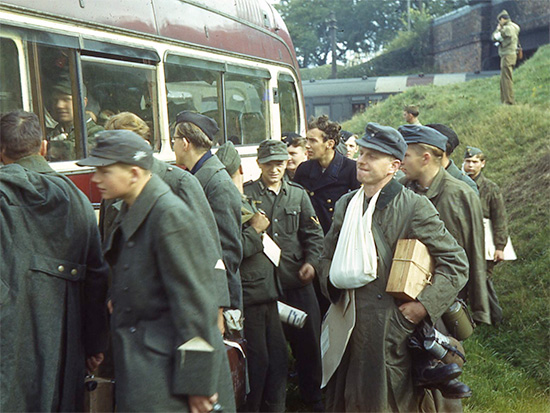
German PW patients are boarding buses at the Malpas railway station, enroute for the 82d General Hospital installations at Iscoyd Park, Flintshire. The prisoners represented many different branches and services of the German Armed Forces.
Further Operations United Kingdom 1944:
From 1 October 1944 until 31 December 1944, the 82d General Hospital under the command of Colonel John W. Rich, remained at its initial overseas installation at Iscoyd Park, Flintshire, Wales. The unit’s mission was not altered by the hospitalization of enemy sick and wounded after having cared for American and Allied patients up to 28 September 1944.
The organization on 31 December 1944 consisted of the following personnel:
Medical Corps > 35 personnel
Dental Corps > 5 personnel
Medical Administrative Corps > 8 personnel
Quartermaster Corps > 2 personnel
Sanitary Corps > 2 personnel
Chaplain Corps > 1 personnel
Army Nurse Corps > 78 personnel
Physio-Therapy Aides > 2 personnel
Hospital Dietitians > 3 personnel
Warrant Officer, Junior Grade > 1 personnel
Enlisted Men > 488 personnel
Civilian Employees > 29 personnel (Post telephone system, heating, sewerage, utilities)
A number of Officers from the unit were temporarily reassigned during the above period. They were:
- Captain Edward A. McClintock, MC, O-319326, 21 October 1944, to the Zone of Interior for urgent personal reasons.
- Major Paul B. Hamilton, MC, O-490330, 31 October 1944, for appointment as Chief of Medical Service at the 109th General Hospital.
- Captain William J. Harty, Ch, O-498477, 15 November 1944, to the Zone of Interior for medical reasons.
- Major Ralph M. Bell, MC, O-402485, 29 November 1944, as Chief of X-Ray Service to the Zone of Interior for medical reasons.
- Captain Louis D. Chapin, MC, O-447640, 4 December 1944.
- Major Ralph Rosenberg, MC, O-346475, 12 December 1944.
- Major Edward W. Alsberg, MC, O-268030, 12 December 1944.
- Captain Kurt Katzman, MC, O-515307, 13 December 1944.
- 1st Lieutenant Adam M. Hauer, MC, O-525138, 29 December 1944.
The following more important duty assignment changes were carried out:
- Captain Harry B. Hargus, MC, O-499929, Chief of Neuro-Psychiatric Surgery, 26 October 1944.
- 1st Lieutenant Charles W. Fessler, MAC, O-2047985, assigned to the unit 4 November 1944 and appointed Personnel, Finance, and Rehabilitation Officer.
- Colonel Cornelius F. Lehmann, MC, O-157864, Chief of X-Ray Service, 1 December 1944.
The weekly patient census between 1 October and 31 December 1944 numbered the following patients:
6 October 1944 > 603 Admissions
13 October 1944 > 259 Admissions
20 October 1944 > 9 Admissions
27 October 1944 > 12 Admissions
3 November 1944 > 13 Admissions
10 November 1944 > 6 Admissions
17 November 1944 > 8 Admissions
24 November 1944 > 11 Admissions
1 December 1944 > 7 Admissions
8 December 1944 > 454 Admissions
15 December 1944 > 20 Admissions
22 December 1944 > 319 Admissions
29 December 1944 > 12 Admissions
31 December 1944 > 2 Admissions
The American Red Cross personnel were eventually withdrawn 1 October 1944 as the organization was now charged with the hospitalization of enemy PW patients. There were 42 German female civilians transferred to this hospital most of whom were assigned to ward details assisting in the care of the Prisoner of War patients. The conversion of the 82d General Hospital for PWs was accomplished with minimum difficulty in the administrative transformation. The many and diverse directives relating to the Registrar Officer were readily applied and the smooth functioning of that department during the change over was a credit to the direction and excellent training of that office.
The Prisoner of War patients were guarded with the aid of a Military Police Detachment from the 415th Military Police Escort Guard Company, used as a security guard consisting of 55 Enlisted Men, commanded by 2d Lieutenant Sidney E. Jacobson, CMP, O-1798863. There were no instances of attempted escape or other significant breaches in discipline by any of the PWs. Enemy patients who required no further treatment and were awaiting transfer to a PWE were assigned to various work details as part of their rehabilitation. PX rations, including articles such as cigarettes, were made available to the enemy patients even though, ironically, the command, as all U.S. Army personnel, were for a certain time denied all cigarette rations.
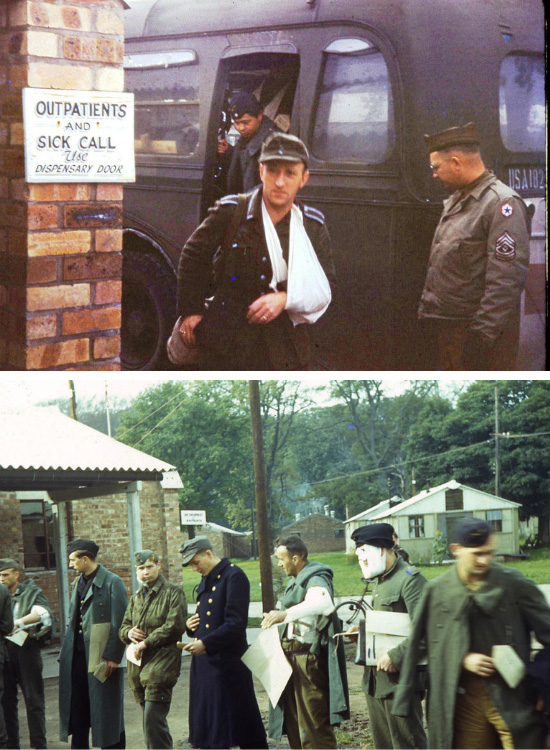
Debarkation of German Prisoner of War patients from the buses that brought them to the 82d General Hospital’s installations, at Iscoyd Park, Flintshire. The prisoners stand in line waiting to be admitted to the hospital plant.
The professional care rendered to these PW patients was not less than that given to American or Allied personnel. The number of blood transfusions given to German sick and wounded up to the end of 1944 totaled 202, and two hundred and seventy-five patients were given over 18000 physio-therapy treatments. Considering the poor physical condition of many of these patients, who had remained without benefit of any local or systemic therapy (sulfonamide or penicillin) for long periods after sustaining their wounds, the recoveries were unusually striking and the mortality rate unusually low. No major amputations were performed. Conservative treatment in cases of very severe fractures of long bones with considerable longitudinal bone defect showed remarkable spontaneous healing. Several of these cases had been told by their own German Medical Officers that amputation was inevitable. The Orthopedic Section improvised from scrap material devices to prevent ankylosis and fibrous arthritic changes in all cases of wrist drop or peroneal nerve injury; a hinge device was improvised to permit knee action with plaster cast fixation of the leg for tibial fractures. There were 815 plaster casts applied to German patients in the last quarter of the year. Nine (9) colostomies were closed without complications, and 1 arterial aneurysm and 1 arterio-venous fistula successfully treated by surgery. The extensive infections of most wounds amongst the PWs resulted in delayed secondary closures and longer periods of healing after closures. Several pleural decortications were performed for the higher incidence of complications of chest wounds in the enemy patients. Further surgical treatment of head and chest injuries was performed by the 82d General, at times assisted by specialist personnel detached by the various other hospitals in the VI Hospital Group (Provisional). The Surgical Service of the organization performed 90 major operations and 627 minor procedures upon the German Prisoner of War patients up to 31 December 1944. There were 6 eye enucleations, all but one having been replaced with acrylic prostheses. The medical cases revealed a high incidence of pulmonary Tuberculosis, particularly among the conscripted Georgian and Polish captives who had been previously subjected to forced labor under adverse shelter and dietary conditions. The Medical Service was charged with the general care of chest injuries for which a special ward was organized. The scientific conduct of the section earned a written commendation from the Senior Consultant in Medicine, ETOUSA, for both the Chief of that particular Section, Captain William Cohen, MC, O-333376, and the Chief of Medical Service, Lt. Colonel Frederick Kellogg, MC, O-284789. The Dental Service noted a marked incidence of caries and root infections, the latter due to poor denervation technique attempted by German dental personnel. The X-Ray Service performed 2421 x-ray examinations between 1 October and 31 December 1944, while the Laboratory Service did over 8000 clinical laboratory tests on the PW patients.
The overall mortality rate was 4.081 per 1000 prisoner patients. There were 9 deaths, with causes such as: massive hepatic necrosis – multiple cerebral abscess – pulmonary septic infarction – and spinal cord lacerations with extensive decubitus ulcer and acute pyelonephritis.
The 82d General Hospital, with a number of others, functioned under the jurisdiction of the VI Hospital Group (Provisional), formerly the 6810th Hospital Center. Coordination and policy regulation by this Headquarters proved to be advantageous to all parties concerned. Professional meetings took place on a group basis, with Group Consultants appointed, and Motor Transportation pooled for expediting ambulance convoys. The PW patients mostly arrived in large convoys by informal transfer through VOCO, Headquarters VI Hospital Group (Prov). Large numbers of Prisoner of War patients arrived by train to the medical facility.
The operation of the Quartermaster laundry unit on the Post greatly eased the problem of adequate hospital linen, and indirectly, lightened the burden on the motor pool by curtailing the long haul to the Birkenhead civilian laundry.
An air raid alert on the 82d General Hospital Post occurred between 0600 and 0645 on 24 December 1944. The report of the sentry indicated three to five explosions which were either audible or felt. The sounds suggested V-1 type of missiles (buzz bombs) passing nearby, followed by an explosion to the north of the Post area where the flash was seen. Several other bombs exploded to the east and south. There was no local damage.
In order to compensate for the possible loss of additional Army Nurse Corps personnel from the unit, 30 Enlisted Men were selected for a thorough course of training to qualify as full-time replacements. This group was chosen on the basis of aptitude and ability to assume all ward responsibilities normally fulfilled by ANC personnel.

More enemy PW patients arrive at the 82d General Hospital medical installations.
Considering that the command was charged with the care of enemy patients, the morale and discipline were of a high order. This was especially enhanced by the completion of the Post Theater and the Enlisted Men’s Club. These additional facilities were built by the men themselves with the use of scrap and salvage material, and by purchases for interior furnishings with funds made available by the Hospital Fund Council. The Theater was regularly used for dances, USO, ARC shows, classroom training and orientation lectures. The Mess, Postal Service, Post Exchange and leaves or passes had much to do with the excellent morale and discipline of the unit.
In order to keep everyone in good shape, intensified physical training of the command personnel took place during the last quarter of 1944.
The 82d was often inspected, and the Post frequently rated superior by the inspecting Officers. On 14 November 1944, a special inspection was made by Maj. General H. B. Vaughn, CG, United Kingdom Base, with excellent results.
Operations United Kingdom 1945:
The 82d General Hospital under the command of Colonel John W. Rich, MC, O-16973, continued to function through V-E Day at its initial overseas installation, Iscoyd Park, Flintshire, Wales.
Total number of Patients admitted between 1 January 1945 and V-E Day: 3940 (peak figures reached in February and April 1945).
By 8 May 1945, the organization consisted of:
Medical Corps > 27 personnel
Dental Corps > 5 personnel
Medical Administrative Corps > 8 personnel
Quartermaster Corps > 1 personnel
Sanitary Corps > 2 personnel
Chaplain Corps > 2 personnel
Army Nurse Corps > 72 personnel
Physio-Therapy Aides > 3 personnel
Hospital Dietitians > 3 personnel
Chief Warrant Officer > 1 personnel
Enlisted Men > 419 personnel
Civilian Employees > 34 personnel (for maintenance work)
Two groups of Enlisted Men were reassigned to the Infantry and transferred to Reinforcement Depots. Thirty-two (32) on 28 February 1945, plus 30 on 17 March 1945. Officers, reassigned from the unit during the period 1 January to 8 May 1945 were as follows:
- 1st Lieutenant Myron E. Veseth, MC, O-534235, 9 January 1945, to the 101st Airborne Division, Third U.S. Army.
- Lt. Colonel Lawrence Miscall, MC, O-439413, 18 March 1945, to the 45th General Hospital.
- Captain Idar J. Herring, DC, O-464326, 27 March 1945, to the Detachments of Patients, Hospital Plant # 4191, 129th General Hospital.
- Captain Paul E. Ferne, MC, O-535656, 5 April 1945, to the 348th Station Hospital (returned to this unit 13 May 1945).
- Major Irving Wolin, MC, O-420979, 10 April 1945, to the Detachment of Patients, Hospital Plant # 4191, 129th General Hospital.
The following Officer replacements were received:
- Captain Harmon P. Wetherbee, MC, O-1689336, assigned to the 82d General Hospital, 8 April 1945.
- 1st Lieutenant Jack Diener, DC, O-545352, assigned to the 82d General Hospital, 18 April 1945.
Eleven (11) ANC Officers were reassigned, either to other medical units for duty or to Patient Detachments for hospitalization and return to the Zone of Interior.
A number of Officers received new duty assignments and included:
- Captain Waller H. Griffing, MC, O-438409, assigned as Chief of X-Ray Service, 11 January 1945.
- Major Stephen Reynolds, MC, O-349921, assigned as Chief of Venereal Disease Section, Medical Service, 19 April 1945.
- 1st Lieutenant Thomas F. Pritchard, MAC, O-1543323, assigned as Registrar, 27 April 1945.
- Chaplain (Captain) Richard G. Whelan, ChC, O-480025, assigned as Post Chaplain, 8 May 1945.
On 21 February 1945, the unit American Red Cross personnel were reattached to the command and consisted of: Assistant Field Director Jean Hosner, Recreation Worker Martha Condit, Staff-Aide Mary Martin, Staff-Aide Margaret Bryan, and Secretary Ruth Hanna, who all joined the unit 2 March 1945.
On 8 January 1945 there occurred the first Post wedding of the command with Captain James Mulvill, MC, O-512055 and 2d Lieutenant Agnes Doyle, ANC, N-703968 as chief participants.
The 82d General Hospital, through “The Stars and Stripes” War Orphan Fund, adopted Mabel Ann S….., born 24 July 1936, case no. 1210, American National Red Cross.
The new T/O & E 8-550 dated 3 July 1944 became operational on 21 February 1945, as per Authority Letter, Headquarters, Communications Zone, European Theater of Operations, U.S. Army, file AG 33 Op. Subject: Organization No. 60, dated 30 November 1944, and Letter, Headquarters, Communications Zone, United Kingdom Base, File AG 320 Op. Subject: Reorganization of General Hospitals, dated 3 February 1945. Nominal corrections were made to conform with the new T/O.

A number of German female civiliand and Nurses were assigned to some of the wards to assist with the care and treatment of the German Prisoner of War patients staying at the 82d General Hospital.
Utilities and Maintenance, Motor Transportation, Salvage (clothing & equipage), Fuel, Communications, POL, were handled by Captain John W. Aitken, QMC, O-1579652. Duties related to the Procurement, Issue, Warehousing, and Accounting for all supplies were performed. A total of 207 requisitions were submitted and necessary supplied procured. These included items of Organizational Equipment, Post, Camp and Station Property, hospital stocks of Clothing and Individual Equipment, salvaged clothing for Enlisted Men of the Detachment, Cleaning and Preserving Materials, Stationary, Laundry, Replacement of items salvaged, materials for General Maintenance and Upkeep of the hospital. Lists of shortages and overages were immediately inaugurated, shortages requisitioned from the various Services and Departments, and overages returned to Class II Depots.
Deliveries of fuel during the early months of the year (1945), were not up to expectations due to labor problems at the suppliers. Coke was consumed as rapidly as provided and coal stocks usually conserved for the Mess Halls had to be drawn upon to provide heat to the wards and billets. Inspection and inventory of all solid fuels on the Post as of 8 May 1945 showed sufficient stocks available and surplus quantities rapidly accumulating.
| Solid Fuel | Received | Consumed |
| Coal | 630 tons | 792 tons |
| Coke | 821 tons | 533 tons |
| Wood | 43 tons | 34 tons |
Key Officer Personnel – 82d General Hospital (1 January 1945)
Commanding Officer – Colonel John W. RICH, MC, O-16973
Executive Officer – Lt. Colonel Quintus NICOLA, MC, O-338283
Adjutant – Captain Lawrence B. EDLIN, MAC, O-1544329
Assistant Adjutant – 1st Lieutenant Charles W. FESSLER, MAC, O-2047985
(replaced by Captain John T. FERRITER, MAC)
Hospital Inspector – Lt. Colonel Cornelius F. LEHMANN, MC, O-157864
Principal Chief Nurse – Major Ruth GREEN, ANC, N-737809
Chief of Surgical Service – Lt. Colonel Lawrence H. GOODMAN, MC, O-315430
Chief of Medical Service – Lt. Colonel Frederick KELLOGG, MC, O-284789
Chief of Laboratory Service – Major Morris F. WIENER, MC, O-264174
Chief of X-Ray Service – Captain Waller H. GRIFFING, MC, 438409
Chief of Dental Service – Major William O. VAN BRUNT, DC, O-342949
Medical Supply Officer – Captain Charles H. MAYO, MAC, O-1543762
Commanding Officer Medical Detachment – Captain William E. KNIGHT, MAC, O-1543614
Special Service Officer – 1st Lieutenant John O. TALLMAN, MAC, O-2048795
Commanding Officer Detachment of Patients – Chief Warrant Officer Leonard A. MORLEY, W-2126264
Post Exchange Officer – Captain Earl K. BURNSIDE, MAC, O-1534226
Post Utilities Officer – Captain John W. AITKEN, QMC, O-1579652
Mess Officer – 1st Lieutenant Edward L. O’TOOLE, MAC, O-1544503
Registrar – 1st Lieutenant Thomas F. PRITCHARD, MAC, O-1543323
Post Sanitation Officer – Captain James M. BEEBE, SnC, O-623811
Information & Education Officer – 1st Lieutenant Benjamin N. HORWITT, SnC, O-522907

82d General Hospital, general formation and inspection by the Officers of the organization. Camp White, Medford, Oregon.
Official Report 25 May 1945:
In compliance with Preliminary Warning Order No. 2676, Headquarters, United Kingdom Base, File AG 370.5 oPGC, dated 22 May 1945, the 82d General Hospital, under the command of Colonel John W. Rich, MC, (RA), O-16973, ceased to function with patients on 23 May 1945, 2400 hours, and immediately prepared for movement. All patients were evacuated to other hospitals by 1800 hours, 23 May 1945.
There were no important changes in personnel between V-E Day and the date of evacuation of the last patients.
Immediate preparation was made for the return of all unit American equipment to US. Army Depots, and all accommodation stores (Program C) to the British authorities.

Major Quintus Nicola (R, with helmet liner) during a road march, while training at Camp White, Medford, Oregon.
Brief Review Significant Data – 82d General Hospital:
Date of Activation > 20 August 1942.
Appointment of Commanding Officer > 30 October 1942 – Lt. Colonel John W. RICH
Departure Advance Party from the Zone of Interior > 21 February 1944 – New York POE.
Departure Main Party from the Zone of Interior > 28 February 1944 – Boston POE.
Arrival Advance Party Overseas > 1 March 1944 – Liverpool, England.
Temporary Station Overseas > 8 March 1944 – Llandudno, Caernarvonshire, Wales.
Arrival Main Party Overseas > 11 & 12 March 1944 – Liverpool, England.
First Station Overseas > 28 March 1944 – Iscoyd Park, Flintshire, Wales.
First Hospital Admission > 27 April 1944.
Closing for Reception of Patients > 21 May 1945 (official date 2400 hours, 23 May 1945)
Total Period of Operation > 394 days – at Iscoyd Park, Flintshire, Wales.
Total Number of Patients Hospitalized > 8,157 – American & Allied
Total Number of Enemy Patients Hospitalized > 2,793
The 82d Gen Hosp took over the Hospital Plant previously operated by the 230th General Hospital (which closed 22 June 1945) at the Hospice Civil, Soissons, opening to receive patients as of 0001 hours, 23 June 1945. It closed 15 August 1945 (APO # 513).
The 1000-bed 82d Gen Hosp opened to receive patients, as of 0001 hours, 27 August 1945, at the Hôpital Militaire Gama, Toul, taking over the Hospital Plant previously operated by the 5th General Hospital, which officially closed 26 August 1945 (APO # 513); Hôpital “Gama” constructed over the period 1892-1914, was a medical installation used by the French, German, and U.S. Armies until 1945. It was later converted to “Centre Interrégional d’Instruction de Santé No. 2″, until 1972, when inactivated. The installation was eventually taken over by the French Army for use as a Mobilization Depot up to 1996.
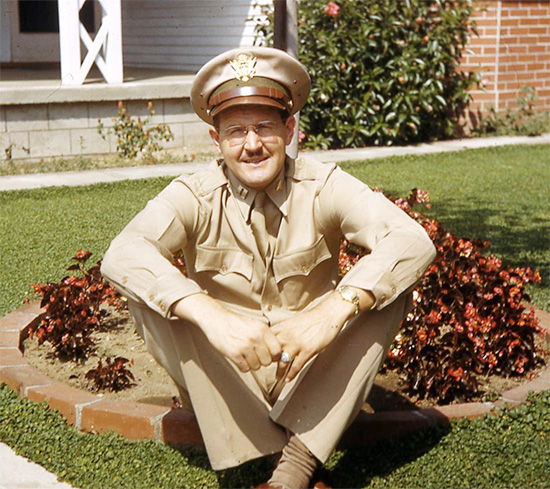
Another picture of Captain Quintus Nicola, who would eventually serve as Executive Officer of the 82d General Hospital.
The MRC staff are particularly indebted to Dennis Nicola, son of Lt. Colonel Quintus Nicola, O-338283, Executive Officer of the 82d General Hospital, for providing them with a substantial number of B/W photos and color slides. These pictures and slides taken by his Father, or in the case of the ones in which he appears, taken with his camera, were a great help for illustrating the pages of this concise Unit History. The authors are still looking for a complete Personnel Roster as well as additional data relating to the unit’s last operations in ETOUSA/USFET . Sincere thanks.
